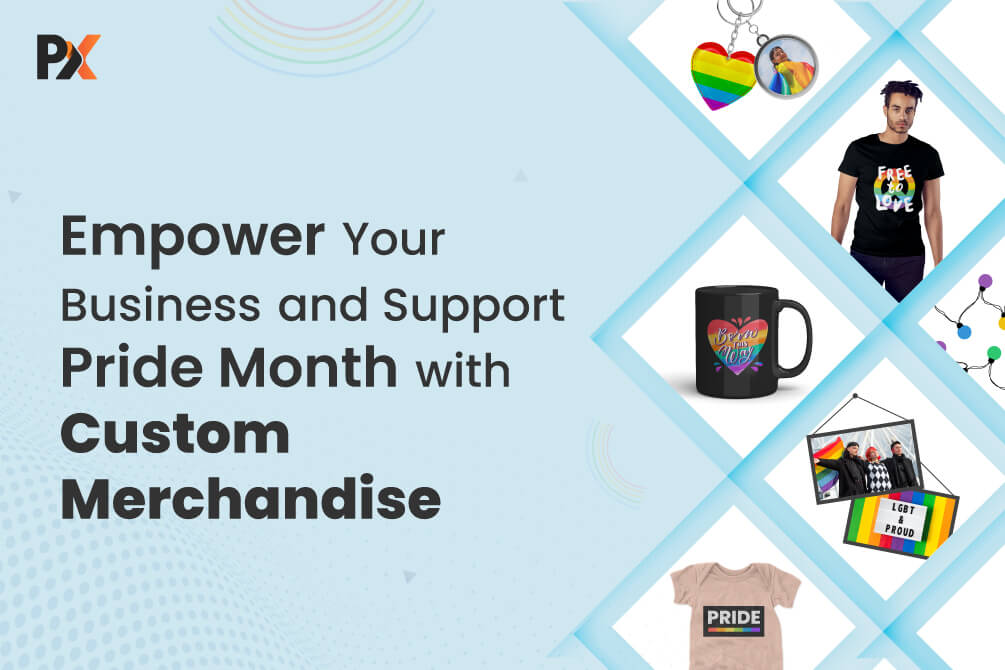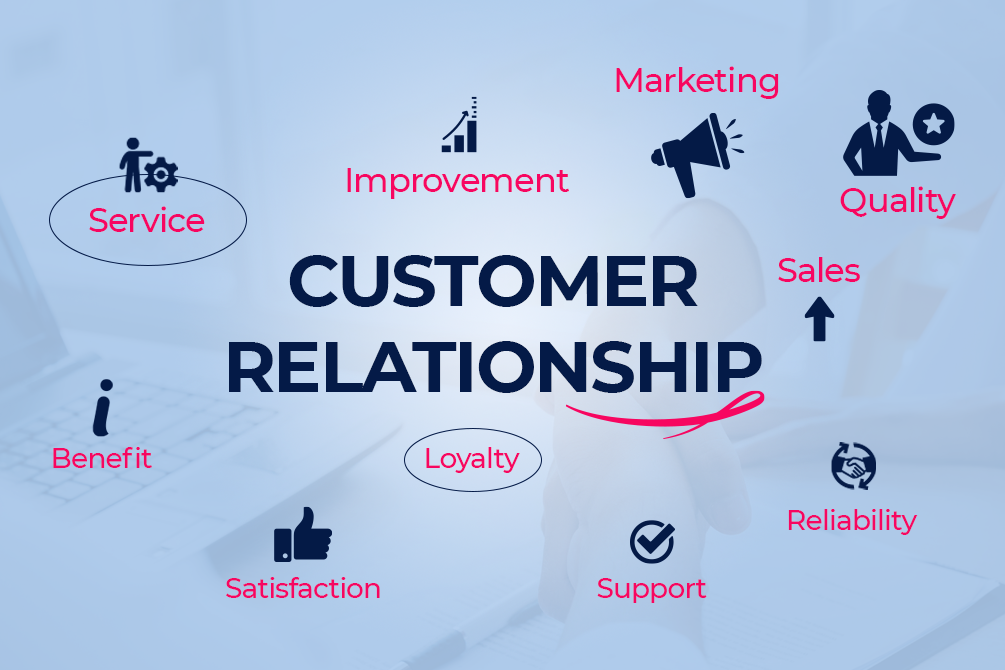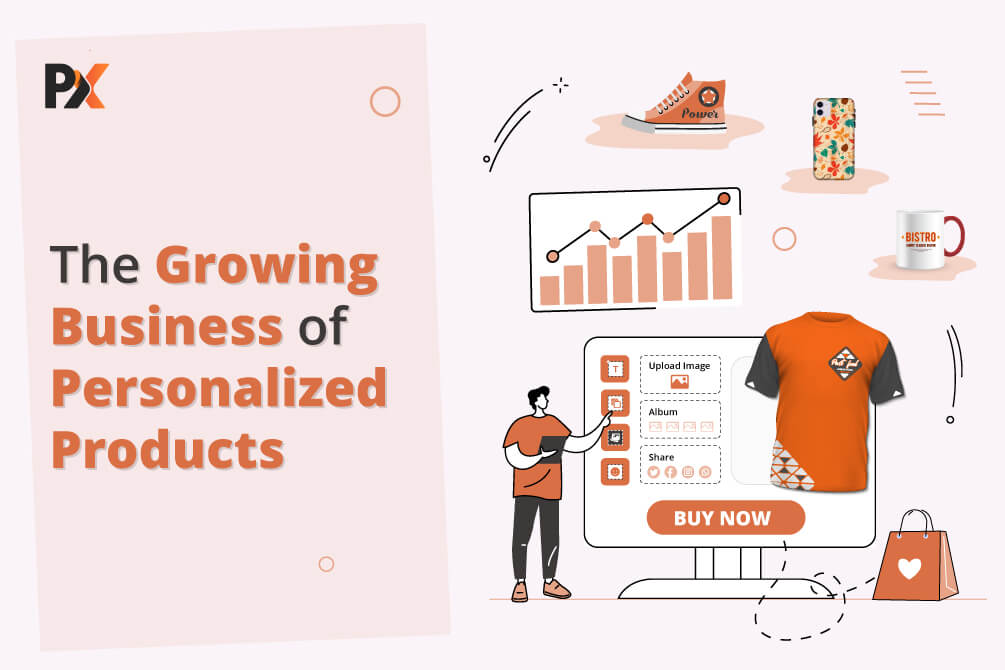
In 1975, the soda giant PepsiCo launched the famous Pepsi Challenge. There was a blind taste test where the participants were not told which beverage was Pepsi and which one was Coca-Cola. The results – Pepsi emerged as a winner.
Later, on being asked if they generally prefer Coca-Cola or Pepsi, Coke was preferred over Pepsi.
Most of them chose Coca-Cola because the attachment people had with the brand was stronger. They were willing to neglect that some other brand could have been their new favorite simply because they had known Coca-Cola for years.
The brand created a solid reputation over more than a century. Coca-Cola’s brand identity consists of – (a) the timeless red logo that reflects energy and confidence. (b) uniquely shaped bottles that tell customers they are not getting an imitation. (c) advertising and messaging that evokes connection and emotion. All these points combined make Coca-Cola a brand and not just a company.
No matter how big or small your business is, it is important to build strong brand identity. It will differentiate you from others and attract people looking for what you have to offer.
This post will discuss how you can create a strong brand identity to build trusted relationships with customers. But first, let’s understand what brand identity is.
Understanding Brand Identity
Let’s understand what brand identity is with an example.
When you hear the word brand identity, you probably visualize big brands such as Apple, Coca-Cola, Nike, etc.
Nike’s logo is one of the most iconic logos in history. The logo has become so famous that the recent ads almost omit the name Nike and just add the logo with the tagline.
Caroline Davidson, only a student at that time, designed the famous Nike ‘Swoosh.’ The design was inspired by the Greek goddess of victory, Nike. The goddess was well-known for her wings which allowed her to fly safely over the battlefield.
Swoosh is a good example of an abstract logo that communicates the brand identity. Now, while the Swoosh is important, it does not entirely reflect what the brand stands for.
The logo was the first step in establishing a strong and memorable brand identity. But the brand has become much bigger today. It has redefined itself from just another shoe company to an athletic and lifestyle brand. What is at the core of Nike’s brand identity is – innovative technology, high-quality products, maximum performance, self-empowerment, and more.
Many businesses think building a brand identity is all about splashing some colors here and there and creating a memorable logo. But that is not a brand. A logo, tagline, colors, illustrations, etc., are just a small step in creating a strong brand identity. To increase the recognition of your brand, you should research big names like the digital branding agency Digital Silk, as they also provide many insightful things to do on your journey.
A brand identity consists of what your brand says, what your values are, how you communicate your product, and what you want people to feel when they interact with it. Essentially, your brand identity is the personality of your business and a promise to your customers. – HubSpot
In the most basic sense, brand identity includes – logo, colors, typography, photography, illustration, iconography, web design, interactive elements, marketing message, unique selling point, customer experience, social media, etc. Here are 11 tips on how to build a strong brand identity.
Here’s a quick outline of all the tips to develop brand identity
- Have a Clear Brand Purpose & Rediscover Brand Position
- Creating Buyer Personas To Develop Brand Identity
- Creating a Brand Identity By Crafting a Unique Selling Point
- Re-evaluate Your Brand’s Visual Identity
- Delivering Better Customer Experience to Develop Brand Identity
- Provide Valuable Content to Increase Brand Identity
- Marketing with The Right Message
- Corporate Social Responsibility to Build Brand Identity
- Invest in Backend Operations for Business Growth
- The Role of Social Media to Build Brand Identity
- Solve The Biggest Problems of Your Industry
1. Have a Clear Brand Purpose & Rediscover Brand Position
Evolution is a requirement for survival. Brands, to survive in the competitive marketplace, keep themselves updated.
For example, the global luxury brand Gucci’s primary target was high-income, middle-aged businessmen and women. The brand soon realized that to appeal to the younger generation, they had to be trendier. In 2015, Marco Bizarre took over as CEO and introduced a brand repositioning strategy that transformed Gucci into a modern brand that appeals to the younger generation.
The brand tailored its product line to match the taste of the younger audience. They even adopted a range of marketing techniques, especially Instagram-style communication. These changes led the brand into a highly lucrative period. Their best so far.
Over the period, it becomes crucial to make calculated adjustments to remake your brand’s identity, especially when (a) growth has stalled and (b) when customers no longer accept what you provided them yesterday.
In an emotionally and financially challenging time for your customers, they want honesty and humanity and not a sales pitch. In fact, 86% of customers say that authenticity is the key factor when deciding what brands they like and support. As a business owner, you need to find a way to communicate that your business cares about something more than just profit and that you will be there for customers in the changing future.
Note that I am not talking about creating a new logo and choosing a different color palette. We will talk about it in the later sections. But the first thing that you need to do to create a strong brand identity is to determine your brand purpose and position. That eventually will help you build a strong visual identity.
A. Brand Purpose
Arielle Jackson, the startup founder, and Google veteran, says – “Your purpose is how you want to change the world for the better.” Jackson recommends this diagram as a guide for determining brand purpose.
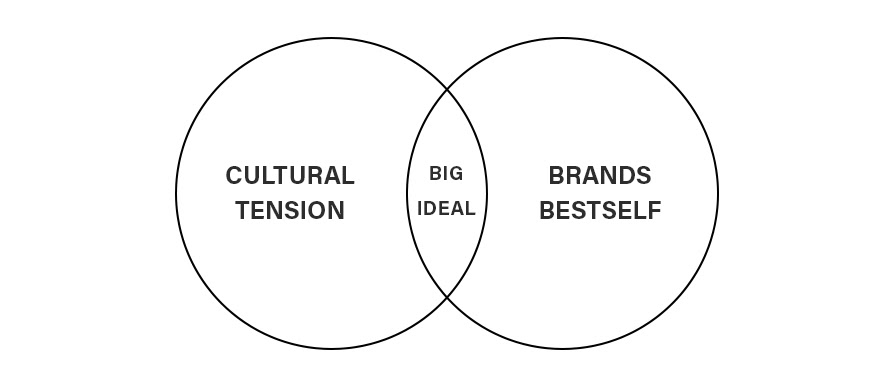
Jackson explains the diagram this way: “In one circle, you have cultural tension. This is what is happening in the world that’s relevant to you. In the other circle, is your brand’s best self. This is what your company delivers at its prime,” says Jackson. “The intersection of these two areas is… ‘the big ideal’ — or your purpose.”
For instance, in 2014, personal care brand Dove used this diagram. The cultural tension that the brand recognized was – due to the rise of photo editing tools like Photoshop, women had beauty anxiety. At its best self, Dove offers an alternative to soap that delivers real care. Combined, Dove’s purpose became – the world would be a better place if women felt good about themselves.
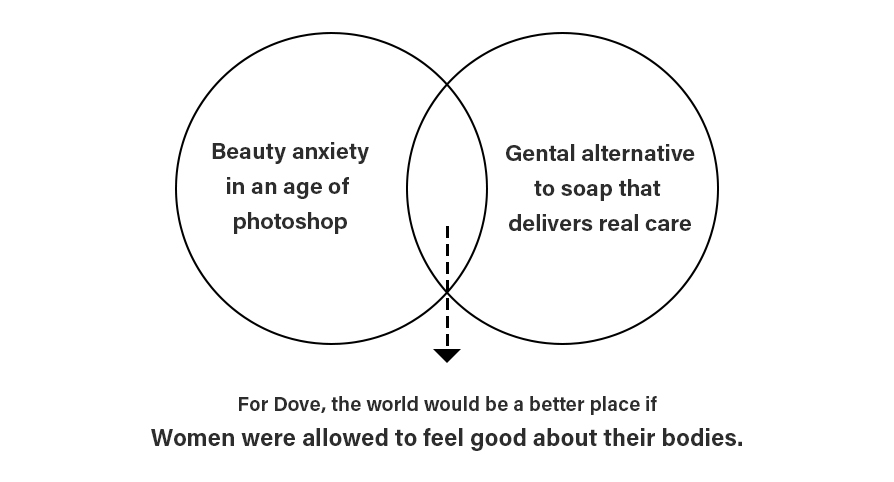
This way, to develop brand identity, determine your brand position by knowing what your product is for and why it is better than the rest.
B. Brand Position
Your brand position is a statement that clearly defines the problem that you are trying to solve, and why your solution is best from the rest. To discover your brand position, Jackson shares a template that can help companies.
For (target customer), Who (statement of need or opportunity), (Product name) is a (product category) that (statement of key benefit) unlike (competing alternative) (Product name) (statement of primary differentiation).

2. Creating Buyer Personas To Develop Brand Identity
‘Put yourself in their shoes’ – you hear this phrase thrown around everywhere. It encourages you to understand and empathize with the circumstances of your target audience. The more your business sees things from your customers’ perspective, the more chances you have to create meaningful relationships with your target customers.
A buyer persona helps you bridge this gap. They are an archetypal representation of every individual in your customer’s buying process. You create these fictional representations from data and represent them with a picture, name, and unique characteristics. Buyer personas should include all the information you need to know about customer behavior, interest, demographics, etc.
But why is it important to create buyer personas?
Let’s consider a hypothetical personal brand selling eBooks on personality development. They realize that the majority of buyers are working professionals trying to improve their personal development skills. Suppose they have detailed information about their audience, such as companies they work with, positions they hold, age, country, etc.. In that case, they can tweak their branding, marketing, and designing to align with the target audience.
This way, a buyer persona not only helps to attract the audience but attracts the right audience to your company. To develop brand identity, think of buyer personas as your potential customers, the real reason why your company exists. That will help you find everything you need – right from call to action to personalized emails to encourage them to engage with you.
Here are some reasons why knowing your customers is important for creating a brand identity.
- Getting insights about your customers will help you create compelling stories that evoke strong emotions and sympathy.
- Buyer personas can help you send targeted messages on the right social media platforms and to the right audience.
- A buyer persona also gives you insights into the design preferences of your customers. For instance, does your target buyer like vintage theme images, realistic pictures, or animations.
- User personas enable you to know what type of content your customer likes. That way, you can avoid subjects or terms that may alienate your customers.
- Buyer personas help you develop a customer buyer journey map. It gives you a straightforward strategy to navigate your customer through the sales funnel.
Develop Buyer Personas for Creating a Brand Identity?
A strong buyer persona contains answers to personal questions about the buyer’s age, gender, income, lifestyle, hobbies, level of education, preferred social media platforms, career, buyer’s pain points, etc.
The most common way to answer these questions is by conducting a one-to-one interview with the current customers. That will give you access to information on challenges or motivation unique to your service or product. Secondly, you can learn a lot about your target audience by conducting surveys asking questions like how helpful your product is to them, how often they use the product, etc.
Once you get these insights, address those factors at each stage of the buyer’s journey. For instance, if your target buyer is at the 1st stage, i.e., awareness, they are probably looking to educate themselves about a product/service. And hence, you address their pain-points via social media or blog post content and then slowly let them know how your business can help them.
3. Creating a Brand Identity By Crafting a Unique Selling Point
There are hundreds of brands selling chocolates. But why is M&M so popular?
In 1981, the company aired a commercial focusing on how their milk chocolate melts in the mouth and not in the hands. M&M is unique because they have a candy coating that prevents the chocolate from melting in your hands.
At that time, with this ad, the brand was trying to differentiate it from others. And it indeed became successful. Their unique selling proposition is not only unique but also long-lasting because we still remember this.
A unique selling point is an answer to the question, ‘how is your product unique from your peers in the market?
Before we talk about what is a USP, let’s see what shouldn’t be your unique selling point.
- Marketing offers like 20% off on product purchase
- Free shipping
- 30-day return policy
- 24/7 customer service
These are no doubt convincing, but they are not unique. Almost every brand has a strong return policy or customer support. There’s nothing that can differentiate you from your competitors.
When I say unique, I mean that you need to try and differentiate around some aspect that your target audience cares about. A unique selling point gives you a position in the market by making your product more memorable instead of generic.
Let’s look at two hypothetical brands as an example.
Brand one offers an extensive product line of t-shirts, hoodies, and other apparel. They even have an offer of buying a pack of four at a reasonable rate. Brand two has a similar product line, but the brand lets the shoppers create their designs, add images, and write text on their t-shirts. Both these brands are popular who won’t compromise in quality.
Now, let’s consider a customer who knows both the brands. When they browse through brand one’s website, they see that there’s nothing outstanding about the products. There are probably 20 t-shirts and pants of the same colors and material hoarded in the wardrobe. But with the other brand, they get the ability to print pictures from their phone gallery or can get a t-shirt denoting the number of their favorite sportsperson.
Which brand do you think the customer will purchase from?
Obviously, the latter.
When products are more or less similar, what sets you apart from others is your product’s value. And there is hardly anything satisfying for customers other than getting tailor-made products. Earlier, this was limited to personalized mugs and mobile covers, but today customers are demanding product customization. They are seeking eCommerce brands that would give them the ability to craft products they love.
Let’s look at a few examples of brands offering product customization.
A. Nike
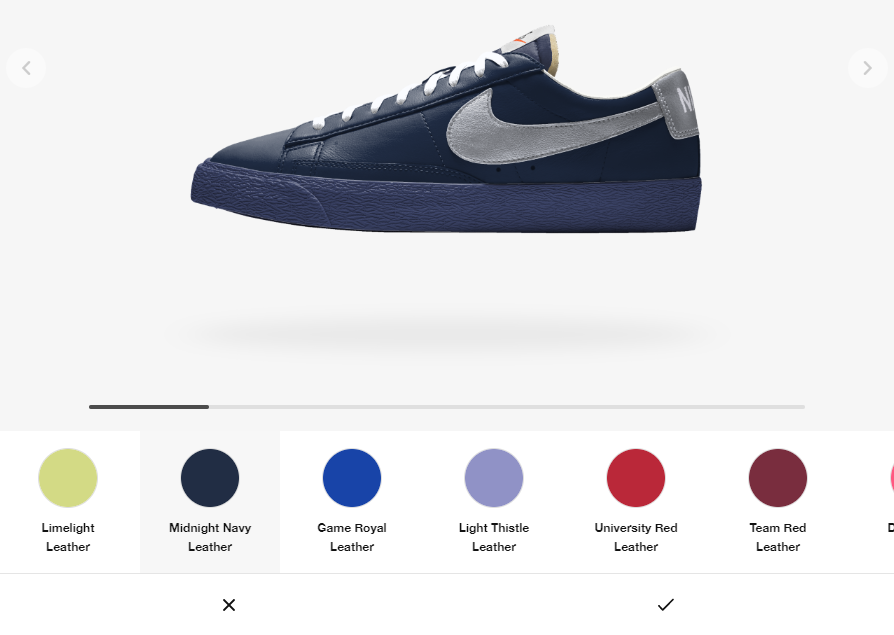
Nike By You allows users to customize sneakers. The product customization starts with a template which leads the shopper to customize different elements like base, lace, sole, Swoosh, etc. The user can select a size, choose different colors, and share their creations with their friends using the share button.
B. Levi’s
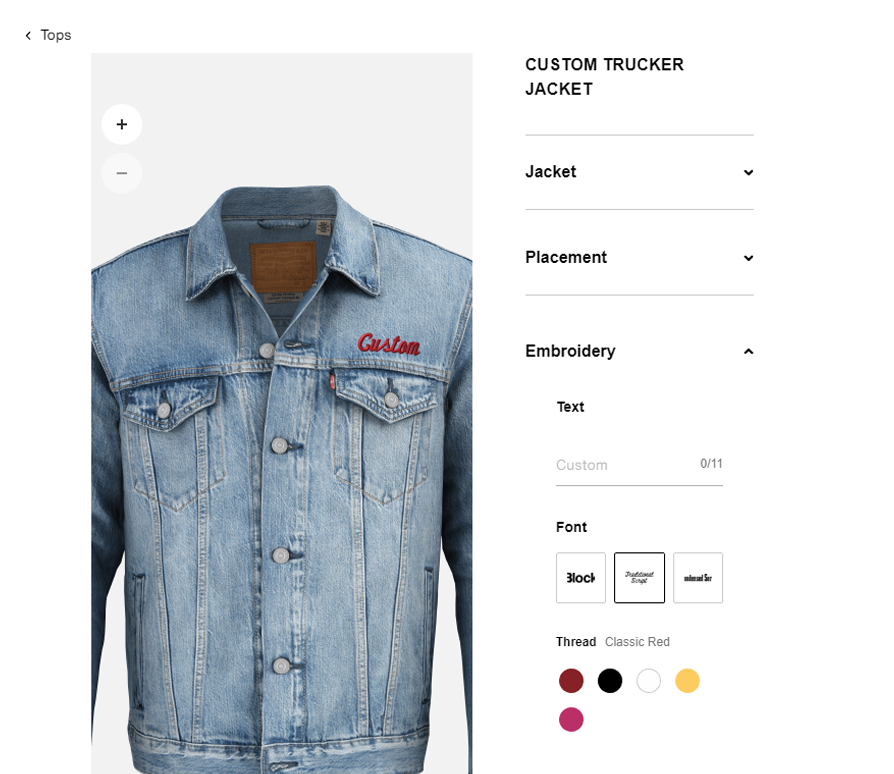
The brand is putting the power of personalization directly into the hands of the customers. After choosing the iconic Levi’s fit, customers can select from three different tints, patterns, color options, etc. to make it their own.
C. Custom Ink
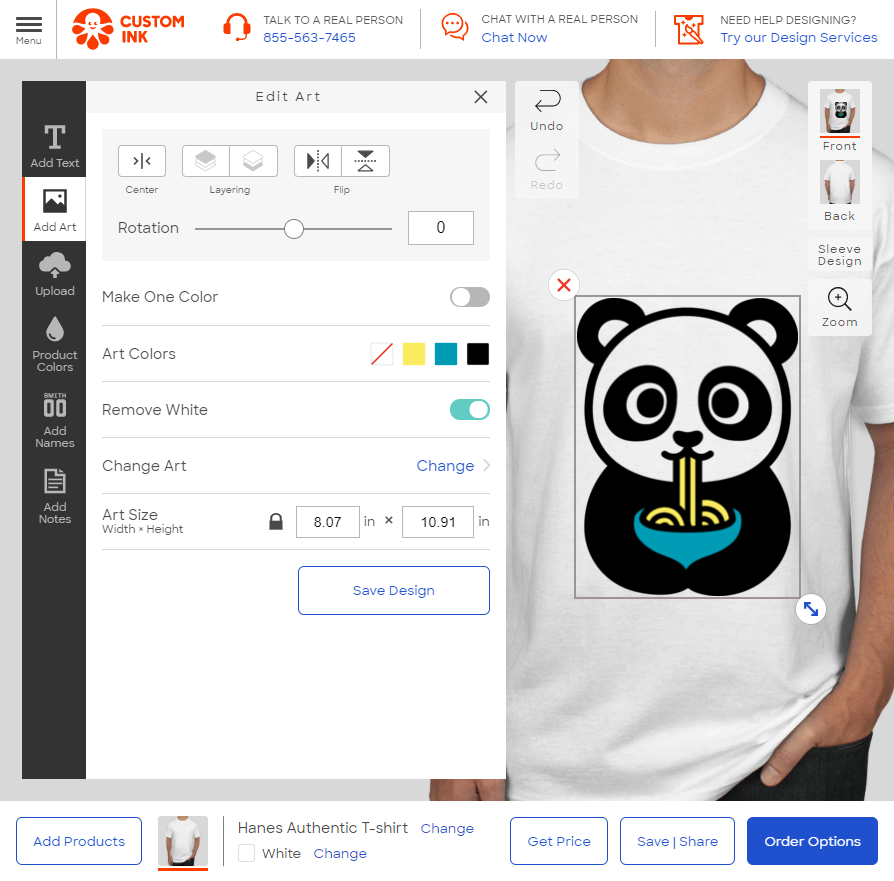
Custom Ink is an American-based online retail company that makes custom apparel. The brand has a dedicated designing lab where you can customize your t-shirts by adding text, art, pictures, colors, etc.
At PrintXpand, we help eCommerce business owners extend their business capabilities with the power of personalization. Our online product design tool is a web-to-print software with diverse features like a ready-made template, text, images, clipart, social media upload, etc., that enables customers to create customized and print-ready designs.
The tool makes printing possible on all products like t-shirts, mugs, shoes, bags, business cards, and more. Moreover, it is compatible with every eCommerce platform. This means you need not worry about what platform your store belongs to. Once you integrate our product design tool, you are ready to sell customized products to your customers.
Why don’t you sign up for a demo to find out how personalization can take your business to the next level!
4. Re-evaluate Your Brand’s Visual Identity
For the first time in twenty years, Burger King changed its logo. According to a press release, the rebrand reflects “recent improvements to taste and food quality, through the removal of colors, flavors, and preservatives from artificial sources from menu items.”
They have ditched the shiny blue stroke and yellow buns for a more minimalist and natural look. The burger-shaped logo features red “Burger King” lettering sandwiched between two toasty orange buns.
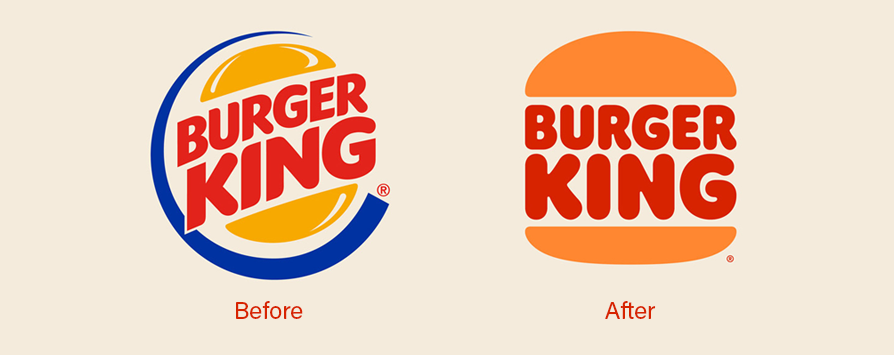
(Burger King changed their logo after twenty years- Image source)
Burger King is not the only brand revamping its visual identity. American automotive company General Motors announced a new logo in more than 50 years that highlights its commitment to electric vehicles. Recently, Kia revealed a new logo and slogan that signifies their new brand purpose.
In the same way, the visuals that helped you build your company might not be relevant today. Either your audience is changing, or you are expanding your business, it’s a fair thing to give a second thought to your existing visual identity. So at this point, you can use a logo maker that will give you a modern logo that reflects your brand!
However, it is important to note that not every brand needs to change its design just for the sake of change. Rebranding is a complex process that involves major changes, right from website and logo design to packaging materials. Following are the 3 signs that indicate that your brand needs to change its visual identity as soon as possible.
Sign 1 – Visual Identity Does Not Reflect Your Brand’s Values
At the core of a strong brand lies a strong identity – your brand purpose, vision, value, and mission. Every visual element like logo, color palette, typography, etc., is an opportunity to reflect what your brand stands for. If you think that the current visual identity doesn’t match what your brand stands for, then you should consider giving a fresh look to increase brand identity.
Sign 2 – If Your Brand is Expanding
A good brand identity is the one that reflects the changes that your company undergoes. If you have introduced a new product line in recent times, or targeted a new group of people, or have expanded your brand globally, then consider adjusting your brand’s visual identity to such changes.
Sign 3 – Your Brand Identity is Visually Inconsistent
To maintain a connection with your audience and to cultivate a specific association with your brand in their minds, it’s important that branding is consistent across all platforms. To check if there is brand identity consistency, just look at your eCommerce website, Instagram, Facebook, Pinterest, and other channels you are active on. If you feel the experience is incohesive across all platforms, that’s a sign that you should not overlook.
Your brand’s visual identity is the face of your brand. That is the first thing your potential customers see. Hence, visuals should speak at the most basic and emotional level that is persuasive to the audience, and at the same time, ensure that it creates the right impression. And if you need assistance in creating the right impression through visual communication, we’d love to assist you.
5. Delivering Better Customer Experience to Develop Brand Identity
The brands that deliver exceptional customer experiences are the strongest. Adidas, for instance, has become a leader in delivering powerful customer experiences. There are three major ways the brand focuses on customer experience.
First, the company tailors’ online messages to match the passions of any customer. This enables them to unify their messaging throughout the customer’s buying experience.
Secondly, Adidas enhances its focus on customers by labeling them a ‘creator consumer – someone who wants to take part in the creation of brand content.
Lastly, to improve the customer buying experience, Adidas gives shoppers a chance to custom-design their products.
Customer experience is the impression your customers have of your brand throughout all aspects of the buyer’s journey. It results in their view of your brand and impacts factors related to your bottom line, including revenue. – HubSpot
To create brand identity, it is important to check that there is no disconnection between the expectations your brand sets and the experience it delivers. To align brand and customer experience, ask these questions
- How and where do customers interact with your brand?
- What do they feel about your brand and the experience it provides?
- Are you able to deliver on your promises?
- Is the experience the same at every customer touchpoint?
Answering these questions will give you an idea of where you stand right now and the places that need improvement to increase brand identity.
6. Provide Valuable Content to Increase Brand Identity
Once you start working in an industry for an extended period, you learn the industry/product/service which makes you an expert. Now, thought leadership is a marketing method where you leverage your expertise to grow your brand. You share your unique experiences, perspectives, learnings, and more with the world.
Sharing thought leadership content would humanize your brand. People will feel like there is a real person behind the brand talking about the most important things within the industry. And that way, people will be able to make authentic connections with your company.
‘Thought leadership is the process of formulating big ideas and insightful points of view on the issues buyers face, capturing those ideas in multiple content vehicles and sharing the ideas with prospects and customers to enlighten them, engage them in a dialogue and position your company as a trusted resource’ – Forrester Research
Let’s look at some good examples of thought leadership content.
- Microsoft has their blog and news page called Stories. This section of the brand goes beyond talking about its core products and publishes news on events and initiatives they undertake. For instance, there’s a post that talks about how software developers are helping companies during a crisis. There is a self-publication of Stories known as Story Labs. It features employee stories and talent behind various branches of Microsoft.
- Survey Monkey, an online survey development cloud-based software company, does an excellent job sharing valuable content. The company has a resources page that covers a wide range of topics.
Here are three ways to develop thought leadership content that will help you build brand identity.
- Counter-narrative opinionsIf you think you have a strong opinion about something contradictory to what your peers in the market hold os against your industry conventions, you can share those counter-narrative opinions. Look at what BaseCamp does. Its co-founders have built their brand on strong opinions about how to do business. Their popular content includes – articles like meetings are a waste of time, their best-selling eBook – it doesn’t have to be crazy at work.
- Personal NarrativeAnother way to share thought leadership content is to turn your experiences into reflections. Ask yourself, ‘is there a unique problem that I solved in my work experience that others do not know about? You can use storytelling to share your insights with others.
- Data StorytellingData makes for top-tier leadership content. Talk about data that your product generates or that you have collected yourself. For example, CB insights are well-known for sharing proprietary data that offers reliable insights on industry-related topics.
7. Marketing with The Right Message
Dove, for years, has remained committed to improving the self-esteem of women. By showcasing a diverse range of bodies and ethnicities, the brand has improved the way women look at themselves. However, the brand faced criticism when they released an ad on their Facebook page that showed a black woman turning into a white woman. Many social media users accused the brand of racism and called for a boycott of Dove’s products. Later, the brand shared an official statement to apologize for the intentional damage the advertisement caused.
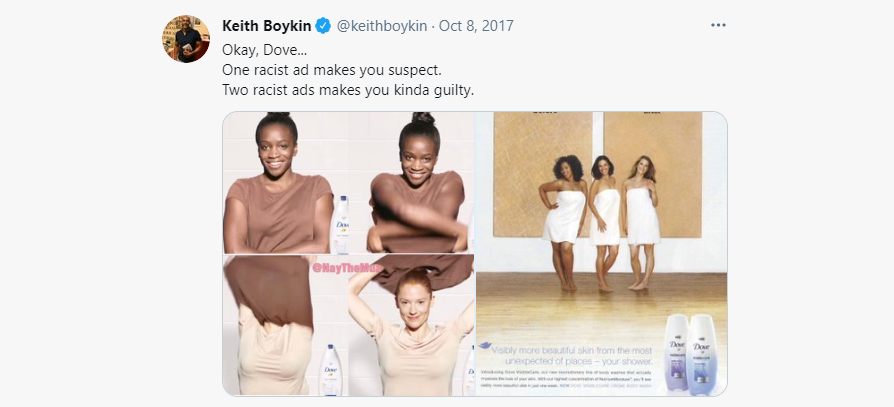
This disastrous ad teaches an important marketing message – your marketing becomes successful only when it delivers the right message.
What is Marketing Message
In simple terms, a marketing message is how you portray your company to your target audience to talk about the brand and what it does. An ideal marketing message should do the following:
- Explain clearly what you do and what is your core offering.
- Should resonate with your target audience to make them feel that you matter.
- Establish trust between your company and your audience.
- Helps the audience understand what problem your brand will help them solve.
All companies, big or small, need to have the right marketing message for creating a brand identity that customers can connect with. A brand that is doing an excellent job with marketing messages is the mega cosmetic brand Maybelline. In the initial years, the brand’s tagline was – Fine makeup, sensibly priced. Later, they focused on the tagline – Maybe she’s born with it, maybe it’s Maybelline. It evokes a feeling of confidence, self-worth, and empowerment among its target audience.
How to Create a Strong Marketing Message
To increase brand identity, your marketing message needs to have a unique selling point. It should explain to your customers what problem you will help them solve and how your solution is different from others in the market. You need to think of your value proposition as a catchy headline.
When creating a solid marketing message, ask yourself these questions
- What – Start with research on the objectives of your organization. Revisit your brand’s mission and develop a message that aligns with your brand’s current and future objectives.
- Who – Once you have identified your company’s objectives, find out who your target audience is. It will help you find an alignment between your brand and your customers.
After you answer these questions, it’s time to compile this information in a document that explains your marketing message. When doing so, always try and see things from the customer’s perspective. Instead of speaking from the point of view of a seller, think about how your customer would like to read or hear the same thing.
Incorrect – ‘Our experts prepared the hair solution that keeps the hair shiny all day.’
Correct – ‘Add some shine to your hair-style because you deserve it.’
Also, a good marketing message is easy to understand. The last thing you want to do is leave your audience confused. Therefore, try and avoid any complex jargon and industry-specific definitions that make the message difficult for your audience to understand.
Incorrect – ‘Our team will help you find if you need a dedicated, shared, or cloud hosting for the website that you want to create for your business.’
Correct – ‘We can help you build a beautiful website to impress your customers.’
At PrintXpand, we help businesses with their digital marketing campaigns. We can help you grow your business online by developing a marketing strategy that suits your business.
8. Corporate Social Responsibility to Build Brand Identity
‘Corporate Social Responsibility is a hard-edged business decision. Not because it is a nice thing to do or because people are forcing us to do it because it is good for our business.’ – Niall Fitzgerald, Former CEO, Unilever
Corporate social responsibility applies to every brand’s reputation irrespective of the size. Starbucks is one example of a brand with a strong CSR. They look for ways to sustain the environment by including a plant-based and environment-friendly menu, reusable packaging, etc.
Here are some facts about CSR that you need to know
- 68% of online consumers in the U.S. and UK would stop using a brand because of poor CSR.
- 84% say a poor environmental track record would cause them to stop buying from a brand.
- Nearly half are willing to pay a premium for socially-conscious or environmentally-friendly brands.
Consumers, especially the younger generation, expect that the brands they support are socially responsible and improve environmental or social awareness. Hence, when you support causes that your audience is passionate about, your efforts will resonate with them, and, ultimately, that will help you build brand identity.
9. Invest in Backend Operations for Business Growth
Backend operations play a huge role in business growth by improving inventory management, supply chain management, customer experience, etc. One such eCommerce tool that is a rage nowadays is a product personalization tool. eCommerce store owners are leveraging product design tools to give more freedom of choice to their customers.
One of the biggest advantages of these tools is that they reduce the need to maintain huge stock and inventory. Instead, businesses can let the customer design products rather than choosing from the available product line.
Product customization has become a must-have feature for eCommerce store owners, and thanks to technology, businesses can easily provide customization. Request a live demo and check how a product design tool can help your eCommerce store.
10. The Role of Social Media to Build Brand Identity
Customers buy products from your brand because they see value in what you offer, and therefore, they trust you. Social media plays a major role in establishing that trust. Online channels like Instagram, Facebook, Pinterest, etc., are a two-way street for communication to engage with your target audience to create deeper relationships and increase brand identity.
Luxy Hair is the perfect example of an eCommerce business that relies on a loyal fan following on social media. The founders, who also happen to be husband and wife, realized that it’s difficult to find hair extensions and solved the problem by creating Luxy Hair.
Their business is based exclusively on YouTube tutorials. Their YouTube channel has over 173 million views, and the reason videos are doing so well is because they give people value and establish personal connections. The brand mostly shares tutorials like how to do Dutch braids, hairstyle trends in 2018, etc. The brand also gets traction from reviewers on the internet. When bloggers review multiple products, Luxy hair comes out on top.
Your eCommerce business can learn from Luxy Hair to always aim to educate rather than sell. When you prioritize delivering value over self-promotion, you can easily gain trust and build a strong brand identity.
Here are three main things to consider when using social media to create a brand identity online
- The way you present your brand across all channels is important. Hence, find a consistent voice, tone, and style and stick to it.
- The frequency of your posts and how active you are in responding to comments also matter. Ensure that you are posting regularly and interact with your followers.
- One of the key factors that will set you apart is originality. Talk about how differently your product can help, what values your brand stands for, share your insights about the market, etc.
11. Solving the Biggest Problems of the Industry to Build Brand Identity
Businesses thrive because they solve problems for their customers. Why do you think Uber became so popular? It is one of the fastest-growing companies globally, available in more than 80 countries worldwide, and has a global market value of $72 billion.
Uber has reached where it is today because it solves one of the world’s biggest problems.
Before Uber, it was difficult for people to get around easily with public transportation. Moreover, the rate of private cab services was way higher than an average consumer’s budget. The founders of Uber were quick in realizing this. They not only gave an economic solution, but transportation has become more convenient than ever. Book a ride with one tap, and hop on into the car.
Uber streamlined and solved the taxi booking problem for the customer by bringing technology into the fold. When you book your ride, you get the identity information and the driver’s picture and the car’s details. Moreover, GPS technology shows you the precise location of where the car is and how long it will take to reach your location.
Similarly, one way to create a brand identity online is to make problem-solving your value proposition. A value proposition is the promise of value you make to your customers. It encapsulates the problems you solve and why the solution is better than others.
To create a value proposition, start by understanding and defining the problem you are trying to solve. Asking yourself these questions will help you create a value proposition to increase brand identity.
- Are there customer problems that lack valid solutions? – Here, do some research and find out gaps in solutions that other business providers are unable to solve. In that case, the market is likely to choose your solution.
- Are there any consequences people will face if they do not use your solution? – In cases where solutions are mandatory, and your target buyer is likely to face unavoidable consequences, it becomes easy for you to explain the value of your product or service.
After you define the problem you want to solve, it is important to evaluate if your solution is unique. It does not necessarily mean that a good solution is faster and cheaper. Your solution might create new benefits by solving the challenges in a unique way.
An example of a strong value proposition is Studio Neat. Studio Neat creates simple products that solve common problems. For instance, Apple TV remote stand is one of their products. Now for those with an Apple TV, they know that losing the remote is a common occurrence. Therefore, it’s a good idea to buy the solution – “You know you’re going to lose it. You won’t if you buy this.”
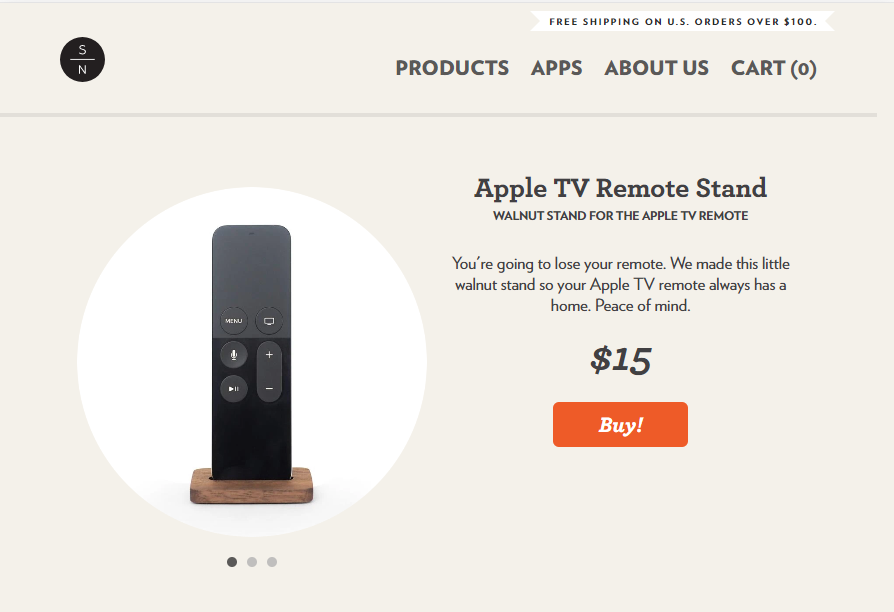
Solving problems is the key to delighting your customers. When they have no complaints about the product or service you offer, they are likely not to look elsewhere the next time they shop something. This improves customer loyalty and attracts new customers through word of mouth.
What is the biggest problem of your industry that you want to solve? Share that problem with us, and we will define a technology solution to solve those problems to increase brand identity.
Over to You
Strong brand identity includes everything from the visuals on your eCommerce store to how you connect with customers on different channels. But if there is one thing that is indisputably critical in forming your brand’s identity, that is customer experience.
Particularly in times of crisis that are emotionally, financially, psychologically so challenging for the customers, one wrong interaction can trigger an immediate effect on customer loyalty and trust.
Months after the purchase, your customer might forget well-crafted content, but they will never forget how you made them feel. Moreover, companies with a customer experience mindset are benefiting. They drive revenue 4-8% higher than the rest of their industries.
So, if you want to increase brand identity, consider making the customer experience a priority. By investing in customer experience, you can change your brand’s growth trajectory and even establish yourself as a leader. Now the immediate question one might have is how to improve customer experience. McKinsey states – Care, creative thinking, and new tools can address customers’ acute needs today and forge stronger ties in the post-COVID-19 era.
By investing in new tools, you streamline your business operations, improve the way customers shop, and increase brand identity. Learn more about how you can revitalize customer experience and build brand identity.
All product and company names are trademarks™, registered® or copyright© trademarks of their respective holders. Use of them does not imply any affiliation with or endorsement by them.

